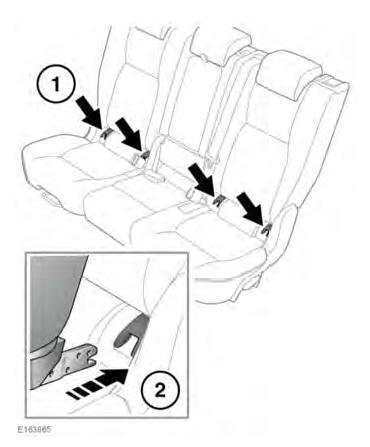Land Rover Discovery: Child restraint check list
Every time a child travels in the vehicle, observe the following:
- Use appropriate child restraints.
- Carefully follow the instructions provided by the manufacturer of the restraint system.
- Adjust the harnesses for every child on every journey.
- Make sure that all slack is removed from the adult seat belt.
- Always attach the top tether when installing an ISOFIX seat.
- Always check the security of the child restraint.
- Do not dress a child in bulky clothing, or place any objects/padding between the child and the restraint.
- Regularly check the fit and condition of child restraints. If the fit is poor, or wear/damage is visible, replace the restraint immediately.
- Set a good example - always wear your seat belt.
- For child seats fitted with a support leg, adjust the leg so that it rests firmly on the floor.
- For some child seats, it may be necessary to remove the head restraint to make sure of a stable fit. Always refit a removed head restraint after the child seat is removed.
Child restraint anchorages are designed to withstand only those loads imposed by correctly fitted child restraints. Under no circumstances are they to be used for adult seat belts, harnesses, or for attaching other items or equipment to the vehicle.
BOOSTER SEATS
In a situation where a child is too large to fit into a child safety seat, but is still too small to safely fit the 3-point belt, a booster seat is recommended for maximum safety. Follow the manufacturer's instructions for fitting and use, then adjust the seat belt to suit.
INSTALLING ISOFIX CHILD RESTRAINTS
Do not attempt to fit ISOFIX restraints to the centre rear seating position. The anchor bars are not designed to hold an ISOFIX restraint in this position.
If the restraint is not correctly anchored, there is a significant risk of injury to the child in the event of a collision or emergency braking.
WARNING: child restraint anchorages are designed to withstand only those loads imposed by correctly fitted child restraints. Under no circumstances are they to be used for adult seat belts, harnesses, or for attaching other items or equipment to the vehicle.
ISOFIX anchorages are provided at the outer seat positions on the second row seats.

To install an ISOFIX child seat:
- Locate the ISOFIX anchor bars and, if fitted, remove the covers.
- Slide the child seat into position and attach the locking mechanism to the ISOFIX anchor bars.
If an upper tether is fitted to the child seat
Test the security of the child restraint. To do this, attempt to pull the restraint away from the vehicle's seat and twist the restraint from side to side. Even if the restraint appears secure, you should still check the anchor points visually, to make sure they are correctly attached.
Note: Always make sure that if an upper tether is provided, it is fitted and tightened correctly.

